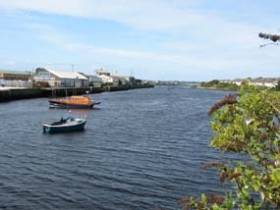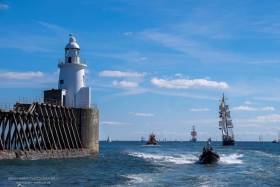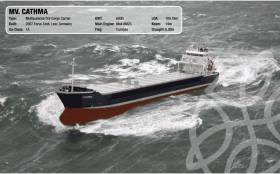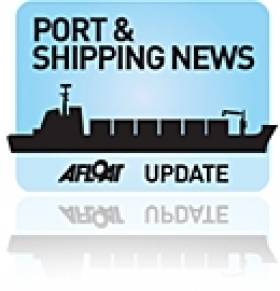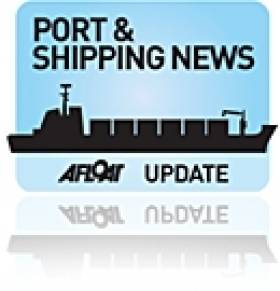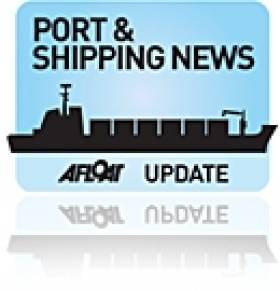Displaying items by tag: Ports & Shipping
Port Snapshot: Sligo Harbour Increase of 18% on Traffic for 2016
#SligoShip - Sligo Harbour has a general cargoship in port today, Arundo one of 18 vessels so far that docked in 2016 an increase of 18% in traffic compared to last year, writes Jehan Ashmore.
Afloat had monitored the cargoship Arundo (1985/1,957grt) at the north-west port having sailed from Rostock, Germany.
According to the harbour master, the ship is discharging lignite (coal) alongside the Deepwater Jetty. On completion of unloading, a departing cargo will be baled waste products bound for The Netherlands where it is to be incinerated.
Sligo Harbour can accommodate ships of 3,500 tonnes and is the only working harbour between Galway and Derry.
Under the Harbours Act 1996 the port was transferred from Sligo Port to the control of Sligo County Council. There are two working jetties the aforementioned Deepwater Jetty, 77m in length and Barytes Jetty of 55m.
Irish Bulker Berths at Blyth Host of Tall Ships Race Diamond Anniversary
#TallShipsRace - Bulker Arklow Meadow departed Aughinish, Shannon Estuary last week bound for the Port of Blyth, where the UK port was host to the North Sea Tall Ships Race, writes Jehan Ashmore.
The Irish flagged Arklow Meadow had loaded at the Rusal Aughinish Alumina plant (see: sister report) from where the 'M' class 14,990dwt bulker departed to round Scotland. The bulker discharged at Blyth where the north-east English port has the Alcan Aluminium Ore Unloading Facility. The South Korean built bulker currently remains at this berth.
At the Northumberland port a spectacular line-up of around 30 entrants of the North Sea Tall Ships regatta gathered for the Parade of Sail and which this year celebrated a Diamond anniversary of the Tall Ships race movement. The North Sea event followed that of the main Tall Ships Race 2016, the prestigious annual race which is also organised by Sail Training International.
It is exactly sixty years since the very first Tall Ships Race visited Lisbon, Portugal in 1956 - an international fleet aptly made a return visit this year, having set off from Antwerp, Belgium. The winner of the Tall Ships Race 2016 was Norway’s Statsraad Lehmkuhl as previously reported on Afloat.ie which visited Dublin Port last month after a cruise-in company to Coruña, northern Spain.
Last week’s sailing spectacular of the North Sea Tall Ships Parade of Sail was held in glorious conditions on the UK’s Bank Holiday at the end of August. As the magnificent tallships departed the Port of Blyth, the Parade of Sail was observed by spectators lining the decks of Princess Seaways, a ferry operated by the Parade sponsor, DFDS Seaways. The Danish shipping company also had something to celebrate, as 2016 marks their 150th anniversary.
Princess Seaways, made the special four-hour cruise to Blyth from Newcastle, further south along the coast. Otherwise the 31,000 gross tonnage ferry normally operates the Newcastle-Amsterdam (Ijmuiden) along with route partner and a sister, King Seaways. The former Val de Loire served Brittany Ferries seasonal Cork-Roscoff route until replaced by current incumbent, Pont-Aven that entered service in 2004 (this year installed with 'scrubbers'). The flagship also operates year round on France-UK and UK-Spanish routes.
Among the North Sea Tall Ship Races participants that were observed from the ferry's cruise, was another Norwegian entrant, Christian Radich, Poland’s Dar Mlodziezy, the UK’s Lord Nelson and the Dutch Morgenster, a visitor to this summer’s Dublin Riverfest.
At the weekend the Tall Ships had completed the 500 nautical mile leg from Blyth having arrived at the Swedish Port of Gothenburg culminating the North Sea Tall Ships Race. This was the fifth occasion that Gothenburg has hosted the Tall Ships.
#CargoshipFocus: Corrib Shipping, a Dublin based ship management company, whose Cathma, one of four cargsoships, is at anchor offshore of Cork Harbour this morning awaiting orders, writes Jehan Ashmore.
The 3,990 gross tonnage Cathma, flagged in Curacao a Dutch island in the Caribbean, had sailed light yesterday from Foynes Port. The cargoship having discharged a cargo of fertiliser from Ventspils, Latvia.
Cathma had taken almost a week to complete the voyage from the Baltic to the Shannon Estuary port, one of six terminals operated by Shannon Foynes Port Company.
Along with her fleetmates, Cathma sails for Corrib Shipping based in Dundrum, Co. Dublin. Founded in 1995, Corrib comprises shipowning companies and employs officers and crew to man its vessels.
Cargsoships of Corrib sail as part of the Royal Wagenborg fleet, in which the Dutch shipping operator (alone has 170 plus vessels) act as chartering agents for the Irish company.
The other members of the Corrib dry cargsoship carrier quartet are Cora Jo, Jolyn and Cathy Jo. The latter vessel likewise of Cathma were built by Ferus Smit’s yard in Leer, Germany.
The shipbuilder's Dutch yard in Westerbroek is where Arklow Shipping Nederland B.V. had their first of 10 ‘C’ class leadships, Arklow Cadet launched in June.
Dominica Flagged Cargoship Trades Scottish Timber to Cork Harbour
#TimberLinks– Coast Lines Shipping Ltd's Ayress discharged round timber at Passage West, Cork Harbour, from where she is returning today to load the same cargo at Campeltown, Scotland, writes Jehan Ashmore.
The privately owned wharf, at Passage West near Monkstown, in the centre of Cork Harbour handles short-sea coasters in which the Dominica flagged Ayress (1979/1,713grt) is a typical example. Branded as the 'Timber-Link' by the Midelton, Co. Cork company, the single hold 80m vessel is due to arrive at Campeltown tomorrow to load more timber.
Such trade between the two countries, Afloat several years ago reported on which can be read by clicking here.
Nearby to Passage West is the local service of Cross River Ferries that uses a pair of former Scottish ferries that ran to Skye, that link communities across the expanse of Cork Harbour. During the summer, the short-cut becomes busier with tourists visiting Cobh and ferry traffic also from France.
As pictured above is the New Pier at Campbeltown on the Mull of Kintyre where timber is exported to Irish ports, notably along the eastern seaboard. Among the ports are: Wicklow (see transfer to local authority), Rosslare and Youghal to the east of Cork Harbour.
On the adjacent berth can also been seen behind the stack of round timber, the gantry structure of the roll-on roll-off linkspan serving Calmac’s thrice weekly operated Campeltown-Ardrossan route.
On Saturday’s only, ferry, Isle of Arran serves her namesake with an en route call to the island at Brodick before completing the sailing to Ardrossan on the mainland.
The seasonal-only route which became ‘permanent’ this season following a three-year pilot trial, is even more secure as CalMac recently signed an eight-year contract to operate Clyde and Hebridean west isles services.
#FarewellRMSstHelena - One of the world’s most remote inhabited islands, St. Helena, a British Overseas Territory in the South Atlantic Ocean is to lose its unique historic shipping service with South Africa, the only sea connection with the outside world, writes Jehan Ashmore.
The combined passenger and freight vessel RMS St. Helena is to be replaced by a 'cargo-only ship' as the first airport on the island was due to have opened last month. Until this takes place, the RMS St. Helena operates the deep-sea service from Cape Town. It was more than two decades ago when RMS St. Helena made a notable once-off call to Dublin and Cobh (Cork) in 1995.
Both the RMS St. Helena and Cunard Line's Queen Mary 2 belong to a unique club of only a handful of vessels designated with the Royal Mail Ship (RMS) prefix.The vessel of the St. Helena Line is operated by AW Ship Management.
The QM2 and the much smaller 6,797 tonnes RMS St. Helena have called to Dublin Bay, however unlike the liner, the latter vessel was easily accommodated in Dublin Port. It was during that call that I recall the Scottish custom-built vessel for St. Helena Island, berthed alongside Sir John Rogerson’s Quay.
The RMS St. Helena was then on a cruise on behalf of Swan Hellenic, which saw her return to Scottish waters where in Aberdeen she was launched in 1990. Albeit, the cruise was focused on the other side of Scotland along the Western Isles.
‘RMS’ as she is referred to by the 4,500 population of the islanders known as the ‘Saints’, was set to make her final voyage to St. Helena in July. The reason for closing the combined service is primarily due to the opening of the airport, though a ‘freight-only ship’ will be introduced to maintain services to Jamestown, the capital. The island is famous as this is the place of Napoleon Bonaparte's exile and death.
RMS St. Helena, her 59 crew and 139 passengers (just 20 short of full capacity), yesterday morning completed a special voyage returning to the UK, London (Tilbury Cruise Terminal). Originally, RMS St. Helena, served the ocean-going service from UK ports (Cardiff then Portland) but then switched operations running out of Cape Town, South Africa.
Later this week RMS St. Helena is to head upriver along father Thames to the Pool of London, where the ship's career of more than 25 years is to be commemorated. (Afloat.ie will have more on this historic and last visit to the UK capital).
After a series of events held in London, the final voyage of RMS St. Helena that is from the UK is to depart on 14 July with the following ports of call: Tenerife, Canary Islands, Ascension Island, St Helena then back to Ascension. From this British Overseas Territory (likewise of Tristan da Cunha) RMS St. Helena heads back to her island namesake before eventually making a final leg to Cape Town due mid-July. This was meant to be the final ever voyage, however (as further explained below) an extension of South Africa only based voyages are scheduled to continue to late September.
The distance of the this South Atlantic voyage is 1,950km/1,200 miles and takes five-days, compared to the planned introduction of scheduled flights to and from Johannesburg, taking a mere six hours. As previously mentioned the new airport remains to be opened. According to a St. Helena Government statement this is due to the challenges of wind shear identified by the first few flights into the airport that began with the first historic trial flights in April.
Work to address this issue is underway at the new airport and the SHG recognise there are St Helenian’s in Cape Town, the UK and Ascension who are ready to return to St Helena and do not have a confirmed means of doing so. Others will be planning journeys in the coming weeks.
SHG will honour its commitment to maintain access by extending the service of the RMS St. Helena as an interim measure and for a limited period until air services begin. This service as usual will be for passengers and freight. The revised schedule of the RMS St. Helena can be viewed here, noting bookings will be accepted from today, Monday 6 June.
According to the St. Helena Line website, the last of the extended voyages is that of Voyage 246 (9th-27th September). This involves a round trip from Cape Town to St. Helena with a call to Ascension Island. The final port of call is to Cape Town which is scheduled for 27 September, marking the end of this chapter in the island's maritime history.
The travel situation is been kept under review and should an air access solution be found quickly, the SHG would need to reassess plans for RMS St Helena.
Shipping Review: Shipping Volumes Up, Tanker’s Tight Squeeze, ESPO to Dublin
#ShippingReview – Over the last fortnight, Jehan Ashmore has reported on the shipping scene as outlined in the following stories below.
Shipping and port activity in the Republic of Ireland rose by 3% in the second quarter of 2015 when compared to the same period of 2014, according to the latest quarter of the iShip Index* published today by the Irish Maritime Development Office (IMDO).
An incredible overhead time-lapse video of the oil tanker Galway Fisher arriving at Galway Harbour recently, showed the skipper’s skills in edging into the tight confines of Dun Aengus Dock.
The European Sea Ports Organisation (ESPO) annual conference will be held in Dublin in 2016. The 13th year of the conferenece will be hosted by the Dublin Port Company and is to take place on 2-3 of June.
#ShippingReview – Over the last fortnight, Jehan Ashmore has reported on the shipping scene.
Smart Tina of 38,900 tonnes became the largest ever ship to call to Greenore. The Co. Louth port having recently underwent an extensive dredging project.
The eight-legged 'walking' jack-up rig Wavewalker 1 carries out maintenance work at Arklow Bank Offshore Windfarm.
Ireland's first Maritime Industry Awards took place in Dublin. The Overall Maritime Excellence Award went to Resolute Marine Energy.
Government approves the Harbour Bill 2015 which allows transfer of Certain Ports to Local Authorities. The ports covered of Regional Significance are Drogheda, Dún Laoghaire, Galway, New Ross and Wicklow.
Dublin Port Company to pay dividend of €8.8 million to the State for the 2014 financial year. The dividend represents 30% of the port's distributable profits for 2014.
For 10 days the Waterford Estuary has seen the dredger Causeway work to maintain required depths of the shipping lane downriver of Belwiew Port.
Stena’s Global Seafaring Institutes Gather in Cork
#Stena@NMCI – The Stena Association of Maritime Institutes (STAMI) held its first meeting of 2015 at the National Maritime College of Ireland in Cork.
It is the first time the association, made up of ten training institutes from three continents, has held one of its bi-annual meetings in Ireland according to the NMCI.
Topping the agenda of the 10th STAMI conference was cultural awareness and teamwork.
Northern Marine was the driving force in the establishment of STAMI in 2009 and continues to support its aims to highlight best practices in the industry and set common standards for maritime training for Stena Group Seafarers.
Training institutes and Industry representatives from across the globe were welcomed to the NMCI where the two-day event ended yesterday.
Afloat.ie adds that Northern Marine manages a multi-national crew of more than 6,000 seafarers operating a diverse range of vessels among them ferries, LPG carriers and VLCC tankers.
An onshore team of 400 provide support staff, technical and ship-management services to include those outside the Stena Sphere.
#MarineJobsRise - 10,000 new jobs could be generated in the marine and maritime sectors of the economy by 2020 according to the Expert Group on Future Skills Needs.
In a EGFSN report "A Study of the Current and Future Skills Requirements of the Marine/Maritime Economy to 2020" it states that there are approximately 16,155 persons employed in the marine economy in marine and coastal regions around the country.
Such roles are spread across the key sectors and straddle the full range of occupations from managerial and professional to operatives, including engineers, marine biologists, maritime lawyers, environmental scientists, naval architects, technicians, and crane operators, fish filleters.
The report estimates that Ireland has the potential to create up to 16,900 job vacancies in the period to 2020 arising through expansion and replacement demand with around 10,000 of these being new jobs owing to growth of the marine economy.
While no major skills shortage was identified the skills in demand include engineers, people with boat handling skills and hydrographic surveyors. Many roles are not exclusive to a marine environment for example electrical and mechanical engineers, lawyers, technicians and welders which are all land based occupations but with a top up qualification or training an individual's skills can be "marinised" to enable them work in a marine or offshore environment.
The seafood sector in particular has an ageing workforce for which measures will need to be put in place to attract and upskill younger workers.
Operatives and low skill roles are a major component of the marine economy but there is evidence of a shift towards more professionals being employed right across the economy including sectors such as seafood which is predominantly a low skill employer and the emerging sectors, such as marine renewable energy and maritime monitoring where professionals such as engineers is the major skill in demand.
A key finding in the study is the lack of awareness about possible careers in the Marine Economy and the time delay in obtaining current economic data for the marine economy. Welcoming the launch of the report, the Minister for Skills, Research and Innovation Damien English T.D said: "I welcome the report which was a key deliverable under the Action Plan for Jobs.
It highlights the positive outlook for the future of the sector and shows that there is significant employment growth expected. The study also highlights the scope for regional job creation and opportunities for young people to obtain local employment in growing sectors; such as aquaculture, supply and services to the offshore energy sector and technology in the marine environment."
Chairperson of the EGFSN, Una Halligan said "With our position on the western periphery of Europe facing the Atlantic Ocean and its energy resources, our deep water ports and our 7,500 km coastline Ireland is well placed to capitalise on the growing potential of the global marine economy and create sustainable jobs in the coastal regions. However, an important aspect will be the co-ordinated effort on the part of all the marine sectors to raise awareness of the excellent and rewarding careers in the sector and attracting people to the opportunities available."
The full report and its recommendations are available to download by clicking HERE.
#PortVolumesGrowth – Port volumes increases in 2014 were more than 2% as measured by the iShip Index*, the IMDO's volume index for all freight traffic moved to and from the Republic of Ireland.
Results of the reseach carried out for the Irish Maritime Transport Economist publication indicate that cargo volumes weretracking Ireland's economic recovery last year.
Commenting on the 2014 traffic figures, Liam Lacey, Director of the Irish Maritime Development Office said, "Irish ports coped comfortably with the growth recorded in 2014. Total volumes have not yet reached the levels recorded prior to the economic downturn in 2007 and at 914 points, port traffic remains more than 12% behind the high-water mark of 1,042 points recorded in 2007. As a result of the volume gains recorded in recent years and in anticipation of future growth, some of our major ports are now preparing to add capacity and in some cases, development plans are at an advanced stage".
Unitised trade, which includes RoRo and LoLo traffic grew strongly, reflecting both improved export performance and increased consumption in the domestic economy. LoLo traffic grew by 9% to over 793,000 teu, while RoRo traffic was up by 7%, with total volumes exceeding 943,000 vehicles.
Total bulk traffic, which includes dry bulk, liquid bulk and break bulk cargoes fell by 2%. This volume decline is largely attributable to the reduced demand for imported fuels and animal feed, resulting from unusually mild weather conditions in 2014.
The growth in traffic was not evenly distributed across the port network. Dublin Port's LoLo and RoRo volumes were up by 9% and 8% respectively and Dublin remains the main /dominant port for unitised trade, with 54% of the LoLo market and 49% of the RoRo market. LoLo traffic also grew strongly through the Port of Cork and was up 12% on the previous year, while Rosslare Europort recorded a 1% increase in its RoRo volumes.
Bulk cargoes, which remain concentrated in Shannon Foynes, Cork and Dublin, with 37%, 25% and 20% of the market respectively, increased strongly through Greenore, Drogheda, Galway and Waterford. With the abolition of milk quotas early in 2015, agricultural output is expected to generate spin-off opportunities for regional ports to capitalise on increased agricultural output, as evidenced by the recent decision of Glanbia plc to invest €157mn in a major new dairy facility near Waterford Port.
Ireland's trading performance is affected by international economic influences. Growth in the global economy remained sluggish at 2.6% in 2014 and was lower than initially expected, continuing a pattern of disappointing outturns over the past several years. Within Europe, the competitive realignment brought about by the lower-valued euro, the positive effects of lower oil prices and the strengthening in overall German economic activity have assuaged concerns about recession in Europe.
In the context of these macro-economic factors and buoyed by growth in the United Kingdom and the United States, our two most important trading partners, Ireland's GDP grew by 4.8%, compared to the 0.2% growth in 2013. Exports increased by 2.4% to €89bn, while imports grew strongly by 7.1% to €53.6bn. Although the Irish economy has not yet returned to the levels of output previously recorded, there is evidence of steady progress. Our ports and shipping services are playing their part by facilitating international trade and supporting the export led recovery.
In the passenger traffic sector, Irish shipping contributed to the 9%** growth in annual tourist visitors by adding capacity on established routes and introducing new services in and out of the Republic of Ireland.
Irish Ferries opened a new service between Dublin and Cherbourg and also increased capacity on the Dublin – Holyhead route, with the introduction of the Epsilon. Stena Line introduced a superfast service on the Dublin – Holyhead route and has established a presence on the Rosslare-Cherbourg route through the acquisition of Celtic Link.
Overall, 4.5 million passengers travelled to and from Ireland by ferry in 2014. During 2014, 238 cruise ships made port calls to the island, bringing approximately 396,391 cruise passengers and crew to Ireland. Dublin Port remains the busiest cruise port in the Republic, followed by the Port of Cork.
Volume 12 of the Irish Maritime Transport Economist is available to download from this LINK:
*iShip Index: The iShip index is a volume index for all freight traffic moved to and from the Republic of Ireland. This does not include passengers and transhipment activity.
**Fáilte Ireland's annual tourism industry review 2014



























